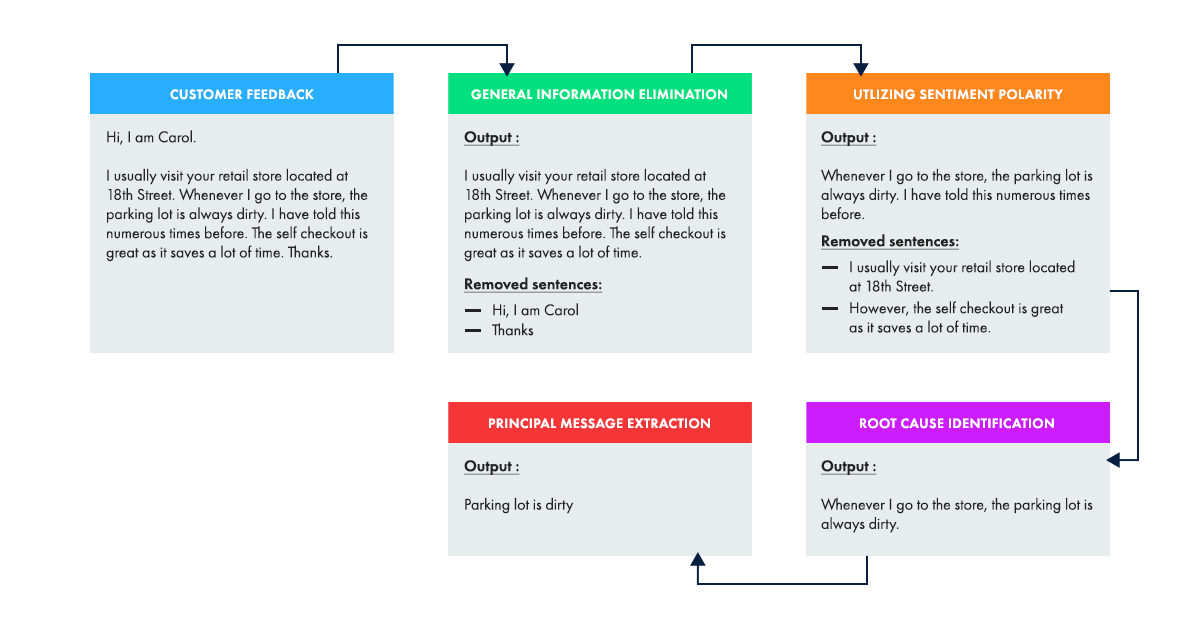
The most successful companies worldwide know that the key to turning customers into brand loyalists is exceptional customer service. Consumers are often willing to spend more and opt for a specific brand that provides good customer experiences. However, with the multitude of choices available to the average customer, identifying and solving consumer problems is not enough anymore. Therefore, brands must be willing to invest more to provide customers with personalized experiences to stand out.
Today, many businesses leverage Artificial Intelligence (AI) and advanced Natural Language Processing (NLP) solutions to understand all facets of customer relationship management. They gather a large amount of unstructured data in the form of audio calls and text data from various channels like feedback surveys, grievance reports, and social media. An in-depth analysis of such data will allow them to fine-tune their business strategies, establish new contacts, improve customer retention, and accelerate growth. This is where NLP solutions can take the lead in understanding feedback and translating them into actionable intelligence for companies.
Understanding textual data by leveraging NLP solutions
Each expression, phrase, or sentence is a small element of a broader discourse used to articulate an idea or communicate the message. Understanding the entire message at a base level is the key to realizing the full potential of data.
Comparing the sentences: “Your car service is not good” and “I had to wait for more than 3 hours for the car service,” shows that the latter contains more valuable information as it indicates a long waiting time for the car services.
NLP technologies help discern these subtle differences to determine the root cause of customer complaints so that organizations can better understand and bridge the service gaps.
How actionable insights can elevate customer service
With basic NLP solutions like topic modeling and sentiment analysis, customer interaction can be understood at a high level. However, such solutions often prevent organizations from identifying the exact cause of customer dissatisfaction.
Let us look at the example below to understand this further:

These examples show the topics and sentiments for the corresponding sentences. Although the information we obtained from the topic and sentiment analyses is valuable, the exact reason for the customer disappointment is missing. To understand the precise rationale for customer dissatisfaction, it is essential to understand “car service has a waiting time” and “the parking lots are dirty” and not just the sentiment behind the feedback. Advanced NLP solutions help convey this information to companies by analyzing unstructured data and extracting insights from it.
At Tredence, we strive to move beyond the conventional topic analysis and create advanced NLP technology to provide actionable insights using semantic and syntactic information from large text data. The actionable insights feature is developed using statistical algorithms, unsupervised machine techniques, and state-of-the-art deep learning techniques and can be customized to fit different business domains. However, to make the data sets more precise, removing irrelevant or low-level information and identifying parts of the text that may convey the opposite sentiment is essential. There are two kinds of processes used to fine-tune the data set:
1. General Information Elimination
NLP solutions often filer out stop words and generic details in most text corpora, such as salutations, personal introduction, or reference identifiers present. This is done using advanced natural language processing solutions like Part of Speech (POS) tagging and term frequency-inverse document frequency (TF-IDF) methods.
2. Utilizing Sentiment Polarity
It is undeniable that customer complaints will have a negative outlook. Since the feature focus on identifying the cause of customer complaints, it is essential to distinguish between positive, neutral, and negative sentiments in the feedback text.
Let us explore the earlier example:

Extracting Relevant Information from Text
To accurately identify the customer problem, it is essential to extract relevant information from the text. Even after eliminating information like stops words and polarized sentiment words, identifying the root cause and the primary message in the feedback is crucial to gain more accurate insights.
Root Cause Identification
Using Bi-directional Attention Flow, data analysts can obtain the root cause of the feedback and classify it into negative, positive, or neutral. In the above example, the root cause for dissatisfaction is conveyed by saying, “I had to wait for more than 3 hours for the car service.”
Principal Message Extraction
To better understand why this step is essential, let’s take a look at a sentence: “I went to your store to pick up some milk and eggs for my family, and while parking my car, I noticed that your parking lot was completely littered with trash all around.”
The algorithm has correctly identified an applicable sentence; however, it still contains non-valuable details along with the key reasons for the complaint. To obtain the core message, which in this case is that “the parking lot is littered with trash,” a BERT-based model is used to associate the semantic role of the word/phrase with the correct context.
NLP: The Changemaker in Customer Experience Strategies of Tomorrow
Exceptional customer service is the building block of any growing business today, and the vast amount of data available from these businesses remains underutilized. Our NLP services can analyze the unabridged data available from customers and mold it into intelligence that will help you improve customer retention and increase revenue.
We also offer thematic analysis to analyze qualitative data and identify underlying themes that are flagged repeatedly. Are you puzzled about how to use the petabytes of data generated every day? Our experts are on standby to help you solve the most complicated data-driven challenges. Drop us a line today to know more.

AUTHOR - FOLLOW
Neeti Nair
Data Scientist
Topic Tags




